By Kay Cattarulla
This article originally appeared in the Fall 2004 issue of LEGACIES, A History Journal for Dallas and North Central Texas. Reprinted with permission.
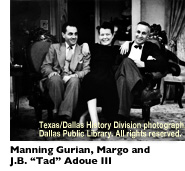 In the summer of 1954, Margo Jones, the Dallas theater director, received a letter from her friend and play scout Jean Baptiste “Tad” Adoue, III. He had discovered a script, he told her – a courtroom drama that had been submitted to eight Broadway producers. All eight had turned it down, and the authors, Jerome Lawrence and Robert E. Lee, had given up hope for a production. Adoue thought the play would appeal to, and challenge, Margo.
In the summer of 1954, Margo Jones, the Dallas theater director, received a letter from her friend and play scout Jean Baptiste “Tad” Adoue, III. He had discovered a script, he told her – a courtroom drama that had been submitted to eight Broadway producers. All eight had turned it down, and the authors, Jerome Lawrence and Robert E. Lee, had given up hope for a production. Adoue thought the play would appeal to, and challenge, Margo.
It “will take GUTS to do in the bible belt,” he wrote.
“It’s called Inherit the Wind.” 1
Inherit the Wind did, in fact, receive its world premiere six months later in Dallas (many would add “of all places”), the conservative, fundamentalist stronghold that might have seemed like the last place where it could get a fair hearing. Nonetheless, the play landed in a city ideally suited to giving it a chance – thanks to four features that Dallas, perhaps alone among American cities of the mid-1950’s, could put together: a professional theater, a director able to mold Inherit the Wind‘s many scenes and characters into a powerhouse whole, a critic whose voice was heard and respected nationally, and an audience with an instinctive understanding of the material.
The production, which opened on January 10, 1955, launched a play that has since become world-famous. It was also Margo’s last hurrah.
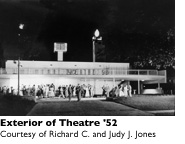 The theater and director
The theater and director
Margo Jones had founded her theater-in-the-round in Dalla’s Fair Park in 1947. She was committed to producing new work and classics only – no re-staging of formulaic Broadway hits. Her success, especially in the early years, had drawn national attention. The theater had begun with a burst of talent. The first season featured world premieres of Summer and Smoke by Tennessee Williams and Farther Off from Heaven (subsequently retitled Dark at the Top of the Stairs), the first play by William Inge, who later went on to write Bus Stop, Picnic, and Splendor in the Grass. 2
It was the first non-profit, professional, resident theater in the country, and Margo saw it as a first step in creating “a dramatic map for America.” 3 She envisioned an eventual national network of professional playhouses that would free theater artists from the commercial pressures of Broadway and democratize the American stage. This would eventually happen in the 1960s and ’70s, when the American regional theater movement got underway. Margo’s book, Theatre-in-the-Round, would be called the movement’s Bible because of its nuts and bolts explanation of production strategies she had devised in Dallas – among them her practice of hiring New York actors to perform as a resident company and marketing each season’s plays as a subscription series.
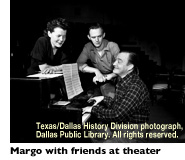 By 1954 Margo Jones had blazed a trail through the theater world with her energy, idealism, charm, and drive, and was well known as “The Texas Tornado.” But some of the creative spark had gone out of her life and career. Her creative partnership with Tennessee Williams had ended painfully, as had a love affair with her business manager, the New Yorker Manning Gurian. She’d failed several times as a Broadway director after starting out virtually at the top in 1945, as co-director of Williams’ breakthrough play, The Glass Menagerie. Her theater in Dallas was chronically short of money. Some critics were faulting her choice of plays, and some local theater-lovers were beginning to speak of a new, larger facility, to be created on a verdant plot near Turtle Creek (it would open in 1959 as the Dallas Theater Center.) Margo gamely endorsed the new venture, although inevitably it would draw support away from her own small venue. Margo’s theater held a maximum of 198 people in less than total comfort. “Not as bad as the Cotton Bowl, but almost” is theater patron Nancy Hamon’s remembrance of the seats. 4
By 1954 Margo Jones had blazed a trail through the theater world with her energy, idealism, charm, and drive, and was well known as “The Texas Tornado.” But some of the creative spark had gone out of her life and career. Her creative partnership with Tennessee Williams had ended painfully, as had a love affair with her business manager, the New Yorker Manning Gurian. She’d failed several times as a Broadway director after starting out virtually at the top in 1945, as co-director of Williams’ breakthrough play, The Glass Menagerie. Her theater in Dallas was chronically short of money. Some critics were faulting her choice of plays, and some local theater-lovers were beginning to speak of a new, larger facility, to be created on a verdant plot near Turtle Creek (it would open in 1959 as the Dallas Theater Center.) Margo gamely endorsed the new venture, although inevitably it would draw support away from her own small venue. Margo’s theater held a maximum of 198 people in less than total comfort. “Not as bad as the Cotton Bowl, but almost” is theater patron Nancy Hamon’s remembrance of the seats. 4
Lawrence and Lee had had one Broadway success in 1948, called Look Ma, I’m Dancin’! Inherit the Wind seemed unlikely to be their second.
The play was based on the 1925 Scopes “Monkey Trial” in Dayton, Tennessee that tested the right of a high school teacher to introduce Darwin’s Theory of Evolution into his classroom. The two leads were based on the two real-life contending lawyers – the defense attorney Clarence Darrow and the God-invoking political orator William Jennings Bryan. Broadway producers had sensed box office poison in their long courtroom speeches. In addition, the content was controversial.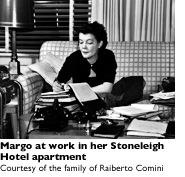 But the play appealed to all of Margo’s instincts. She judged scripts intuitively (“I only know how to judge plays by goose flesh,” she’d written to William Inge in 1947), 5and she was determined to do this one. When she met the playwrights in New York, she greeted them with her favorite line from the play: “An idea is a greater monument than a cathedral.” As she continued to quote their own words to them – “…and the advancement of man’s knowledge is more of a miracle than any sticks turned to snakes or the parting of the waters” – the authors realized that they had met a woman who shared their passion. As Jerome Lawrence said later, “Bob and I patted each other on the back, and said, ‘here’s our customer, this is quite a lady.'” 6Margo, too, sensed that a momentous partnership had been made. “You have certainly given me life through this script,” she wrote to Lawrence and Lee. 7
But the play appealed to all of Margo’s instincts. She judged scripts intuitively (“I only know how to judge plays by goose flesh,” she’d written to William Inge in 1947), 5and she was determined to do this one. When she met the playwrights in New York, she greeted them with her favorite line from the play: “An idea is a greater monument than a cathedral.” As she continued to quote their own words to them – “…and the advancement of man’s knowledge is more of a miracle than any sticks turned to snakes or the parting of the waters” – the authors realized that they had met a woman who shared their passion. As Jerome Lawrence said later, “Bob and I patted each other on the back, and said, ‘here’s our customer, this is quite a lady.'” 6Margo, too, sensed that a momentous partnership had been made. “You have certainly given me life through this script,” she wrote to Lawrence and Lee. 7
Margo’s enthusiasm, however, did not guarantee that Inherit the Wind would be appreciated in Dallas. The playwrights had written their drama as a protest against McCarthyism and the political repressions of the Cold War, and the city had taken a sharp turn to the right. Dallasite Bruce Alger was elected to Congress in November 1954 on a wave of anti-Communist rhetoric. In March 1955 a women’s group, the Political Affairs Luncheon Club, would lead a campaign against the Dallas Museum of Fine Arts for keeping the work of “pinko” artists in its collection. Over the next months, patriots would attack both the Museum and the Dallas Public Library for exhibiting work by known or suspected Communists such as Pablo Picasso, Louis Zorach, and Ben Shahn. Initially, the institutions gave ground to the protestors, and by the summer of 1955, Dallas would be drawing censure from the art world. 8
A second touchy issue was the play’s treatment of fundamentalist religion. Lawrence and Lee had used the Scopes Trial in the same way that playwright Arthur Miller evoked the Salem Witchcraft Trials in his drama The Crucible – as a metaphor for community hysteria that tries to silence dissident beliefs.
Alan Woods, Director of the Jerome Lawrence and Robert E. Lee Theatre Research Institute at Ohio State University, points out that “it’s richly ironic that the play is now getting productions in response to efforts to mandate Creationism or Intelligent Design in public education…. Jerry and Bob purposefully selected the debate over evolution because it was settled and no longer controversial.” They believed, says Wood, that the real anti-McCarthy message “would be crystal clear to mid-1950s audiences.” 9
With both the political message and the treatment of religion likely to upset local sensitivities, a production in Dallas seemed risky. Tad Adoue’s warning that it would take guts to stage the play there was echoed by the authors’ own agent, Harold Freedman. “Margo you don’t want to do this play. Everybody will – will crucify you down there in the Bible belt,” Freedman told her over the phone. 10 Margo replied, “I’m doing it, darling.”
During the five years that we researched Margo’s career, as co-producers of the documentary Sweet Tornado: Margo Jones and the American Theater, KERA’s Rob Tranchin and I spoke with a number of people connected to Inherit the Wind and its Dallas staging. We interviewed Jerome Lawrence and Janet Waldo Lee, Robert E. Lee’s widow. We also met with Louise Latham, a former leading lady with Margo’s company, who originated the role of Rachel in the play, and Harriet Slaughter – now with the League of American Theaters and Producers – who’d been a child actor in the production. James Pringle, Margo’s former stage designer, came to Dallas in 2000 to spend an afternoon showing us around the Magnolia Lounge in Fair Park, the site of her theater.
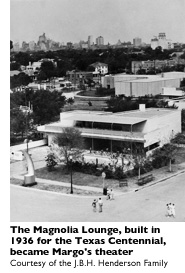 Today, the exterior of the Magnolia Lounge looks much as it did in Margo’s time. Designed by the Swiss architect William Lescaze, the now landmarked International Style building was built by the Magnolia Oil Company as a restroom and information center for the 1936 Texas Centennial. The lobby, with its distinctive, curved glass brick wall, is also unchanged. But the space where Margo erected her arena theater is now a bare room. Pringle explained to us the intricacies of creating entrances, exits, sets and lighting for productions that ranged from Shakespeare and Ibsen to musicals – all on a small keystone-shaped stage with seats on all four sides at floor level and on risers. 11
Today, the exterior of the Magnolia Lounge looks much as it did in Margo’s time. Designed by the Swiss architect William Lescaze, the now landmarked International Style building was built by the Magnolia Oil Company as a restroom and information center for the 1936 Texas Centennial. The lobby, with its distinctive, curved glass brick wall, is also unchanged. But the space where Margo erected her arena theater is now a bare room. Pringle explained to us the intricacies of creating entrances, exits, sets and lighting for productions that ranged from Shakespeare and Ibsen to musicals – all on a small keystone-shaped stage with seats on all four sides at floor level and on risers. 11
Pringle recalled that some in the cast had questioned Margo’s wisdom in presentingInherit the Wind in Dallas. Harriet Slaughter agreed that the production was considered risky in view of residual resentment in the community over the Scopes trial. 12 But enthusiasm grew as the company got to work.
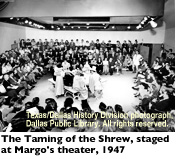 Margo herself had all the skills and experience required to mount a rousing production and to capture on stage the essence of a small Southern town. She had been born and raised in Livingston, northeast of Houston, where her father practiced law. Watching him make speeches in the courtroom, she wrote in her book, Theatre-in-the-Round, was like watching a play. 13 She knew about the role that fundamentalist religion played in the life of a small community: the Joneses were strict church goers, in particular Margo’s mother, who clung hard to God. Margo, more than anyone else, including the playwrights, recognized how theatrically powerful the religious theme would be. 14
Margo herself had all the skills and experience required to mount a rousing production and to capture on stage the essence of a small Southern town. She had been born and raised in Livingston, northeast of Houston, where her father practiced law. Watching him make speeches in the courtroom, she wrote in her book, Theatre-in-the-Round, was like watching a play. 13 She knew about the role that fundamentalist religion played in the life of a small community: the Joneses were strict church goers, in particular Margo’s mother, who clung hard to God. Margo, more than anyone else, including the playwrights, recognized how theatrically powerful the religious theme would be. 14
She was also well grounded in political theater. She had run Houston’s short-lived Federal Theatre Project in 1935, before the Texas Legislature shut it down as too left wing. 15 She had traveled in Europe and Russia, studying politically-tinged drama and observing the powerfully involved audiences. With her amateur group the Houston Community Players, she had presented works by the socially conscious playwrights of the Depression era, including Maxwell Anderson and Elmer Rice. On Broadway in 1946, she’d directed Maxine Wood’s On Whitman Avenue, a play about desegregated housing in Detroit. And in Dallas in 1953, she’d broken the color line with Walls Rise Up, which she directed and presented in her theater with a cast of players from the black Round-up Theatre Company. The city’s first mixed black and white theater audience attended the play. 16
But while Margo had all the convictions and credentials needed to give Inherit the Wind an authoritative production, the Dallas audience remained a question mark.
The audience and the critic
Margo kept excellent records (the Dallas Public Library’s Margo Jones Collection is packed with business files, correspondence, scripts, photographs, clippings, memorabilia, and much more), but she lived before the age of the audience survey.
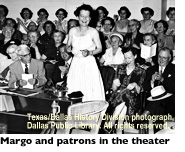 We can surmise, however, that, like Margo herself, many who attended her theater had come from small town or rural backgrounds. Some had been transformed into rich, well-dressed theater patrons with money recently earned from oil, cotton, real estate, and banking. In his memoir In the New World: Growing Up with America from the Sixties to the Eighties, Lawrence Wright describes Dallas, where he grew up, as a city “self created like no other.” 17 But for all their forward-looking optimism and tendency to ignore the past, many Dallasites of the 1950s had roots in small, religious communities similar to the play’s fictional Hillsboro.
We can surmise, however, that, like Margo herself, many who attended her theater had come from small town or rural backgrounds. Some had been transformed into rich, well-dressed theater patrons with money recently earned from oil, cotton, real estate, and banking. In his memoir In the New World: Growing Up with America from the Sixties to the Eighties, Lawrence Wright describes Dallas, where he grew up, as a city “self created like no other.” 17 But for all their forward-looking optimism and tendency to ignore the past, many Dallasites of the 1950s had roots in small, religious communities similar to the play’s fictional Hillsboro.
This alone would guarantee Margo an involved audience for Inherit the Wind, and there were also other strands in Dallas history and society that were on her side.
The city had a progressive tradition, as exemplified by the Civic Federation, founded as far back as 1917 as a forum for continuing education, cultural programs, and political discussions. Margaret Sanger, the crusader for birth control, the socialist Norman Thomas, and labor advocate Max Eastman had all spoken there, along with black educator Booker T. Washington, biologist Julian Huxley, and philosopher Bertrand Russell. 18
Dallas also loved pleasure and entertainment – even today Dallas audiences are regarded as “hot” in theater parlance: eager to laugh and respond. Large crowds flocked to the downtown vaudeville houses lining Elm Street early in the century and attended the same theaters when they were transformed into movie palaces in the 1920s. The highly successful amateur Dallas Little Theater had built a theater tradition from the 1920s to the early 1940s. Dallasites also loved the State Fair – educational but entertaining, with a history of tantalizing spectacles such as the Apple Dance offered by Mlle Corinne (a native Texan) at the 1936 Texas Centennial. In a contemporary newsreel, she appears to have performed totally in the nude. Enjoying its own history as a wide-open town, Dallas was said to have always had “a soft spot for a high class hustler.” 19
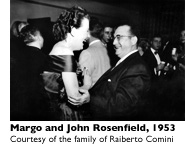 Above all other factors favorable to Inherit the Wind, Dallas had John Rosenfield, the nationally renowned critic of The Dallas Morning News. Rosenfield, more than any other individual, built the cultural institutions of Dallas, and he ran its artistic life with an iron hand. Thanks to Rosenfield, Time magazine wrote, culture in Dallas bloomed “like a rose on the dry plains.” 20 Rosie himself had brought Margo to Dallas to open a professional theater. He supported her beliefs and theater philosophy, although he handed out bad notices freely when her productions disappointed him. He was well-qualified to judge the merits of Inherit the Wind, and his opinion would be heard.
Above all other factors favorable to Inherit the Wind, Dallas had John Rosenfield, the nationally renowned critic of The Dallas Morning News. Rosenfield, more than any other individual, built the cultural institutions of Dallas, and he ran its artistic life with an iron hand. Thanks to Rosenfield, Time magazine wrote, culture in Dallas bloomed “like a rose on the dry plains.” 20 Rosie himself had brought Margo to Dallas to open a professional theater. He supported her beliefs and theater philosophy, although he handed out bad notices freely when her productions disappointed him. He was well-qualified to judge the merits of Inherit the Wind, and his opinion would be heard.
Rehearsals
In December 1954, Jerome Lawrence arrived at Love Field to attend rehearsals. Margo met him, newsreel cameras in tow. Lawrence looks youthful and shy in WBAP Channel 5’s archival footage. Margo, who had appeared aged and unfocused a month earlier at a luncheon in her honor at the Adolphus, looks rejuvenated. Co-author Lee arrived soon after to work with Margo and the cast.
The long courtroom speeches that Broadway producers believed would empty seats were thrilling and gripping to Margo. She dramatized them by placing extras who enacted the jury members on the stairs that separated the sections of the theater. As lawyers directed their arguments into the house, the audience felt that it was sitting in judgment. The small stage and nearness of the audience on all four sides worked to heighten the intensity of the play. The action engulfed the spectators, as Margo intended.
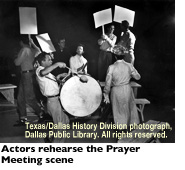 She was equally inventive in the Prayer Meeting scene. Again she placed actors on the stairs, this time as church members. Margo told the cast to seek out and watch Holy Rollers services to prepare for playing the scene – to be ready for “a lot of body movement and a lot of singing.” 21 The music was created by stage manager Fred Hoskins, who was raised in a fundamentalist church in Fort Worth. Hoskins procured a drum to lead the actors onto the stage for the revival meeting, and as Harriet Slaughter recalls, “We came out marching, singing ‘Follow the Fold.'” 22
She was equally inventive in the Prayer Meeting scene. Again she placed actors on the stairs, this time as church members. Margo told the cast to seek out and watch Holy Rollers services to prepare for playing the scene – to be ready for “a lot of body movement and a lot of singing.” 21 The music was created by stage manager Fred Hoskins, who was raised in a fundamentalist church in Fort Worth. Hoskins procured a drum to lead the actors onto the stage for the revival meeting, and as Harriet Slaughter recalls, “We came out marching, singing ‘Follow the Fold.'” 22
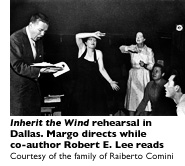 During rehearsals, according to Lawrence, “Margo got dead center and was the Preacher…to have the cast imbibe this, and my God it worked! During the performance, audiences were like part of the Prayer Meeting. They’d see someone in the aisle stand up and shout a Hosannah, and they’d stand up and shout a Hosannah.” 23 The wildness and excitement are still vivid to Janet Lee, who told us
During rehearsals, according to Lawrence, “Margo got dead center and was the Preacher…to have the cast imbibe this, and my God it worked! During the performance, audiences were like part of the Prayer Meeting. They’d see someone in the aisle stand up and shout a Hosannah, and they’d stand up and shout a Hosannah.” 23 The wildness and excitement are still vivid to Janet Lee, who told us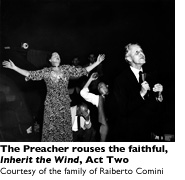 she has never seen the equal of Margo’s staging of the prayer meeting. In the words of journalist Patsy Swank, the scene came “straight out of Margo’s past, and straight out of the past of so many of us that were born in this part of the country and knew a lot about the importance of really functional religion.” 24
she has never seen the equal of Margo’s staging of the prayer meeting. In the words of journalist Patsy Swank, the scene came “straight out of Margo’s past, and straight out of the past of so many of us that were born in this part of the country and knew a lot about the importance of really functional religion.” 24
Both authors doubted that the production would be successful. Janet Lee, arriving for the opening, was met at the airport by her husband, who told her repeatedly, “It’s a disaster.” Lawrence was so tense and exclaimed, “I can’t stand it” so many times, that Margo finally suggested, “Well, Darling, why don’t you just leave?” 25
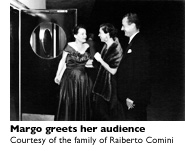 On opening night, January 10, Margo greeted the audience at the door as she always did. The sell-out crowd in black tie, furs and jewels was completely riveted by the play, watching entranced, some joining in the excitement during the prayer meeting. As for the anger that many thought would be unleashed by a play preaching free speech and the dignity of the human mind in the Bible Belt – no complaint was registered.
On opening night, January 10, Margo greeted the audience at the door as she always did. The sell-out crowd in black tie, furs and jewels was completely riveted by the play, watching entranced, some joining in the excitement during the prayer meeting. As for the anger that many thought would be unleashed by a play preaching free speech and the dignity of the human mind in the Bible Belt – no complaint was registered.
The company, the authors, and Margo went back to her apartment at the Stoneleigh Hotel to await reviews, which came in late that night. Lawrence has described Margo kicking off her shoes and reading the notices aloud with tears running down her cheeks.
Virgil Meiers in The Dallas Times Herald wrote that “Margo Jones directed Theatre ’55 through its first premiere of 1955…lighting up a brilliant play. …Theatrical sparks flew…making the burning issue of the right to think sizzle and explode again. It is simply one of the best plays Miss Jones has staged at her theatre, and one of the best productions she has given to a play.” 26
Rosenfield wrote: “a new play of power, humanity, and universal truth found its way into Margo Jones’ Theatre ’55…one of the proudest productions of our unusual theatre.” 27 He compared the playwrights to Shaw and Ibsen. He further pleased Lawrence and Lee by realizing that the part of the journalist Hornbeck was written in iambic pentameter.
New York inquiries began as soon as the reviews came out. The Broadway production was acquired by Herman Shumlin, one of the eight producers who had initially turned the play down. Inherit the Wind opened at the National Theater on April 26, 1955, directed by Shumlin, and produced “in association with Margo Jones.” Margo received her producing credit by virtue of having raised a significant portion of the budget, but Shumlin shut her out of any creative role in the production.
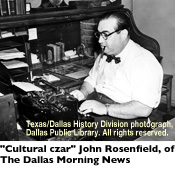 The play was a hit – as John Rosenfield had wryly predicted. It would do well in New York, Rosenfield said, because it “depicted the South that New Yorkers love: the South of tape worms, ignorance and bigotry.” 28 Shortly after the opening, Shumlin brought suit to enjoin Margo from repeating her own production at the end of her Dallas season in May. In still another invaluable news clip from Channel 5, Margo, Shumlin, and her Board Chair Eugene McDermott can be seen in a Dallas courtroom on May 31. Margo, taking the stand, looks like a Southern belle on a charm offensive. She was legally protected by her contract with Lawrence and Lee, and won the case easily. The play had two weeks’ additional run in Dallas, and broke all attendance and box office records in the history of the theater.
The play was a hit – as John Rosenfield had wryly predicted. It would do well in New York, Rosenfield said, because it “depicted the South that New Yorkers love: the South of tape worms, ignorance and bigotry.” 28 Shortly after the opening, Shumlin brought suit to enjoin Margo from repeating her own production at the end of her Dallas season in May. In still another invaluable news clip from Channel 5, Margo, Shumlin, and her Board Chair Eugene McDermott can be seen in a Dallas courtroom on May 31. Margo, taking the stand, looks like a Southern belle on a charm offensive. She was legally protected by her contract with Lawrence and Lee, and won the case easily. The play had two weeks’ additional run in Dallas, and broke all attendance and box office records in the history of the theater.
The Broadway production, starring Paul Muni and Ed Begley, ran for three years, and the play was made into a successful movie with Spencer Tracy and Frederic March. It was revived for the Broadway stage in 1996 and has appeared in three television versions. It continues to be performed all over the world and has been translated into thirty languages.
Robert E. Lee says: “Margo saw in Inherit the Wind the conflict and the drama which not one other person in the American theater saw…she dared. As a result of this experiment in Texas, Jerry and I realized that theater must be allowed to escape from the little bird cage in mid-town Manhattan…. Broadway could not originate its own plays…they should be created on the Texas Fair Grounds, or in Louisville or the Long Wharf.” 29
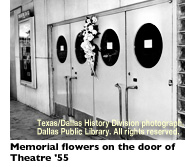 Margo’s vision and courage could have had no more eloquent tribute. She, however, never saw the national theater movement that her work helped to start. On July 24, 1955, she died as the result of a bizarre poisoning accident suffered in her apartment at the Stoneleigh. Headlines such as “Good Night, Sweet Tornado,” national and local obituaries, and a stream of telegrams from theater celebrities attest to the shock of her death, at the age of 43, and to the value of her brief life.
Margo’s vision and courage could have had no more eloquent tribute. She, however, never saw the national theater movement that her work helped to start. On July 24, 1955, she died as the result of a bizarre poisoning accident suffered in her apartment at the Stoneleigh. Headlines such as “Good Night, Sweet Tornado,” national and local obituaries, and a stream of telegrams from theater celebrities attest to the shock of her death, at the age of 43, and to the value of her brief life.
Her theater struggled on for four years, then closed in 1959. Margo’s reputation began to fade. Jerome Lawrence and Robert E. Lee, joined by Tad Adoue, established the Margo Jones award in her memory. Every year since 1961, the award has gone to an individual who has performed outstanding service to the theater. Eugene and Margaret McDermott provided funds to build SMU’s Margo Jones Theater in 1969. A second theater bearing her name was inaugurated at her alma mater, Texas Woman’s University in Denton, in 1982. A plaque describing Margo’s achievements is now displayed in her hometown of Livingston, where she is buried in the Jones family plot.
Despite these efforts, Margo’s name today is largely unknown. A major step in reviving her reputation came in 1989 with the publication of Helen Sheehy’s well-researched, much-praised biography Margo: The Life and Theatre of Margo Jones. SMU Press will issue a new edition of the book in 2005.
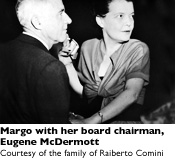 Now philanthropic funds created by her old friends and colleagues have underwritten the one-hour high-definition documentary which was produced by KERA for broadcast on PBS. The Dallas Foundation’s Jean Baptiste “Tad” Adoue III Fund (which also sponsored the Dallas Museum of Art’s tribute to Margo at its literary series “Arts & Letters Live” in 1977) is the lead supporter, together with the Eugene D. McDermott Foundation. The Hoblitzelle Foundation, Nancy B. Hamon, and a group of individual donors, many of whom knew Margo and attended her theater, have also contributed generously to this effort, which has received additional funding from the National Endowment for the Arts, the Texas Commission for the Humanities, the Texas Council on the Arts, and the Dallas Council on the Arts.
Now philanthropic funds created by her old friends and colleagues have underwritten the one-hour high-definition documentary which was produced by KERA for broadcast on PBS. The Dallas Foundation’s Jean Baptiste “Tad” Adoue III Fund (which also sponsored the Dallas Museum of Art’s tribute to Margo at its literary series “Arts & Letters Live” in 1977) is the lead supporter, together with the Eugene D. McDermott Foundation. The Hoblitzelle Foundation, Nancy B. Hamon, and a group of individual donors, many of whom knew Margo and attended her theater, have also contributed generously to this effort, which has received additional funding from the National Endowment for the Arts, the Texas Commission for the Humanities, the Texas Council on the Arts, and the Dallas Council on the Arts.
Texas talent – the actors Judith Ivey and Marcia Gay Harden – perform in the documentary, along with actor Richard Thomas. Next year will mark the fiftieth anniversary of Inherit the Wind‘s triumph, and of Margo’s unexpected death.
“We always say we were born in Dallas as playwrights,” Jerome Lawrence observed. 30 On January 10, 2005, the fiftieth anniversary of Inherit the Wind‘s world premiere in Fair Park, the city that had been expected to end the play’s chances for good can be excused for taking a self-congratulatory bow.
1 J.B. “Tad” Adoue III, undated letter to Margo Jones, Dallas Public Library, Margo Jones Collection, Box 1, folder 3.
2 Margo Jones staged eighty-five plays during her Dallas career, fifty-seven of which were new scripts. About one-third of the new plays had a continued life on stage, radio, or television. Don Wilmeth, “A History of the Margo Jones Theatre” (Ph.D. diss., University of Illinois, 1964), 187.
3 Margo Jones, letter to David L. Stevens, The Rockefeller Foundation, May 20, 1944, Dallas Public Library.
4 Interview with Nancy Hamon, November 7, 2000.
5 Margo Jones, letter to William Inge, August 7, 1947, Harry Ransom Humanities Research Center, University of Texas at Austin.
6 Interview with Jerome Lawrence, November 17, 1999.
7 Margo Jones, letter to Jerome Lawrence and Robert E. Lee, November 10, 1954, Jones Family Archive.
8 For an account of the “Red Scare” at the Dallas Museum of Fine Arts, see Francine Carraro, Jerry Bywaters: A Life in Art (Austin: University of Texas Press, 1994), 172-204.
9 Alan Woods, email to author, March 26, 2004.
10 Interview with Jerome Lawrence, November 17, 1999.
11 The keystone stage was 18′ long and 20′ at its broad end, tapering to 13’10,” according to a theater diagram provided by James Pringle.
12 Interview with Harriet Slaughter, February 27, 2001.
13 Margo Jones, Theatre-in-the-Round (New York: Houghton Mifflin, 1951), 20.
14 According to Janet Waldo Lee (interview, November 16, 1999), the authors did not realize that Inherit the Wind‘sreligious theme would have such a strong impact on audiences.
15 Marion Rhett Walters, “The Federal Theatre Project in Dallas,” Legacies, 10, no.1 (Spring 1998): 35-44.
16 Carol Roark, “The Round-up Theatre: An African-American Amateur Dramatic Company,” Legacies, 10, no.1 (Spring 1998): 50-52.
17 Lawrence Wright, In the New World: Growing Up with America from the Sixties to the Eighties (New York: Vintage Books, 1989), 5.
18 Ronald L. Davis, John Rosenfield’s Dallas (Dallas: Three Forks Press, 2002), 41.
19 June Bennett Larsen, “Margo Jones: A Life in the Theatre” (Ph.D. diss., City University of New York, 1982), 147. This remark was made with reference to H.L. Hunt during a broadcast on ABC-TV, May 30, 1981.
21 Interview with Harriet Slaughter, February 27, 2001.
23 Telephone interview with Jerome Lawrence, February 15, 1997.
24 Interview with Patsy Swank, December 14, 1999.
25 Interview with Janet Lee, November 16, 1999.
26 Dallas Times Herald, January 11, 1955.
27 The Dallas Morning News, January 11, 1955.
29 Robert E. Lee interview, SMU Oral History Program, July 20, 1987.
30 Telephone interview with Jerome Lawrence, February 15, 1997.


